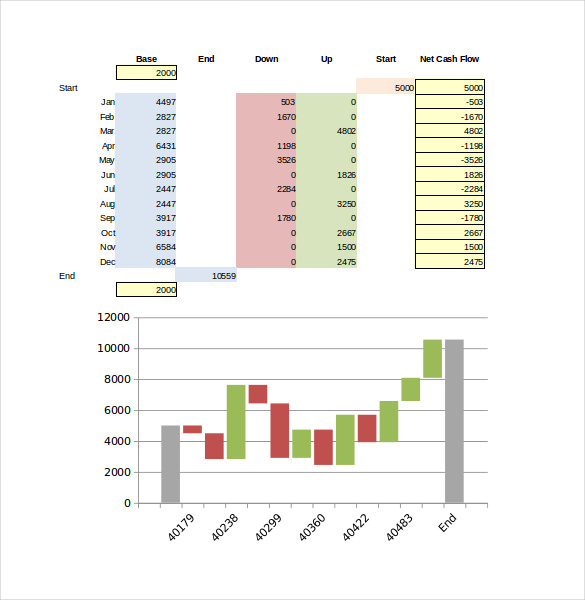
Under ‘Fill,’ select No Fill for the border, and select ‘No line.’
#Create an excel waterfall chart series#

Make the invisible column (base series) have no fill color, and format the ups and downs in your favorite color. Select the data range without the amount column and click Insert > Bar Chart or Insert Column > Stacked Column. You can also copy and paste the formula into corresponding adjacent cells. Step 2: Insert formulasĪfter reorganizing the data, you need to enter formulas in the corresponding columns or first cells and drag them down to the whole column using the fill tool or handle. You can also create a data table with seven columns: period, cash flow, cumulative, start & end, before, after, and data label positions. Down\Fall column: Negative changes in the value.Up\ Rise column: Positive changes in the value.Base column: The starting point for the rise and fall series in the graph.Introduce new columns between two original columns, then name them base, rise, and fall. Below are steps to help you build a waterfall chart. There’s no built-in waterfall chart type in Excel 2016 (and later versions), meaning you have to create one.
#Create an excel waterfall chart how to#
How to build waterfall charts in earlier versions of Microsoft Excel Whole columns usually represent the starting and final values, while color-coded floating blocks represent intermediate values. It can be used to show categorical or sequential data, and the additions and subtractions can be category-based or time-based. Read on! What is a waterfall chart?Ī waterfall chart (also referred to as a bridge chart or a cascade chart) is used to visually demonstrate how a starting value of something becomes a final value through a series of intermediate additions and subtractions. This includes when to use it, why you might need it, and how to create your own. In this article, we’ve got all you need to know about this special chart type. However, it is a popular choice in the world of finance. So, next time you need to analyze financial data, don’t forget to try creating a waterfall chart in Excel.A waterfall chart is one of the lesser-known types of Microsoft Excel charts. With the right data and a few customizations, you can create an effective chart that can help you make better business decisions. In conclusion, creating a waterfall chart in Excel is easy, and it is a useful tool for tracking positive and negative changes over time. You can also add data labels to individual data points to provide additional context. You can do this by adding a title, labels, and annotations that make it easier to understand the data presented. The last step is to add final touches to the chart to make it more visually appealing. From there, you can adjust the fill and border colors, shadow, and transparency settings to create the desired effect. You can format the chart by selecting the chart and choosing the “Format Chart Area” option on the ribbon.

Once you have customized the chart to your liking, you can format it further.

From there, you can add or remove chart elements, such as the legend or titles, change the color scheme, and adjust the chart axis to better fit your data.

You can do this by selecting the chart and selecting the “Chart Elements” button on the ribbon. Now that you have created a basic waterfall chart, you can customize it to better suit your needs. Once you have selected your data, Excel will generate a default waterfall chart. You can either highlight the data on the worksheet or enter it directly into the chart data range. You will see a list of available waterfall chart types, so select the one that best suits your needs.Īfter you have inserted a new chart, Excel will ask you to select your data. To do this, click on the “Insert” tab on the Excel ribbon and select “Waterfall” from the “Charts” dropdown menu. Once you have prepared your data, the next step is to insert a new chart. In addition, you should have columns for the labels associated with each value change. Each change should be listed as a separate row, and the last row should represent the final value. The data should be organized in a table format that includes the initial value, followed by a series of positive and negative changes to that value. The first step in creating a waterfall chart is to prepare your data. In this article, we will walk you through the steps to create a waterfall chart in Excel. This chart is useful in tracking the cumulative effect of positive and negative changes to an initial value over time, and it is commonly used in financial and business analyses. Excel is an excellent tool for creating data visualization, and one such visualization is the waterfall chart.


 0 kommentar(er)
0 kommentar(er)
